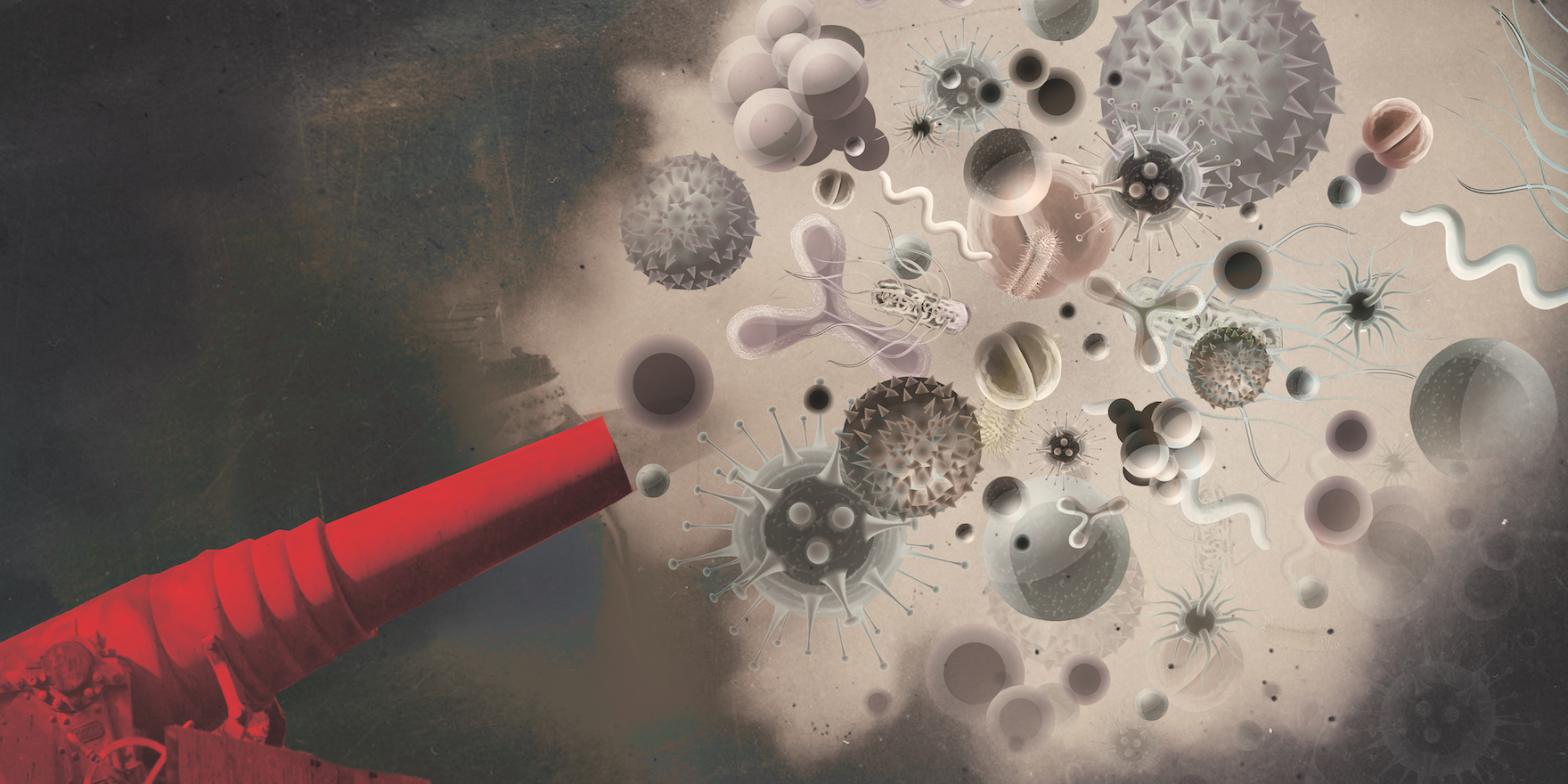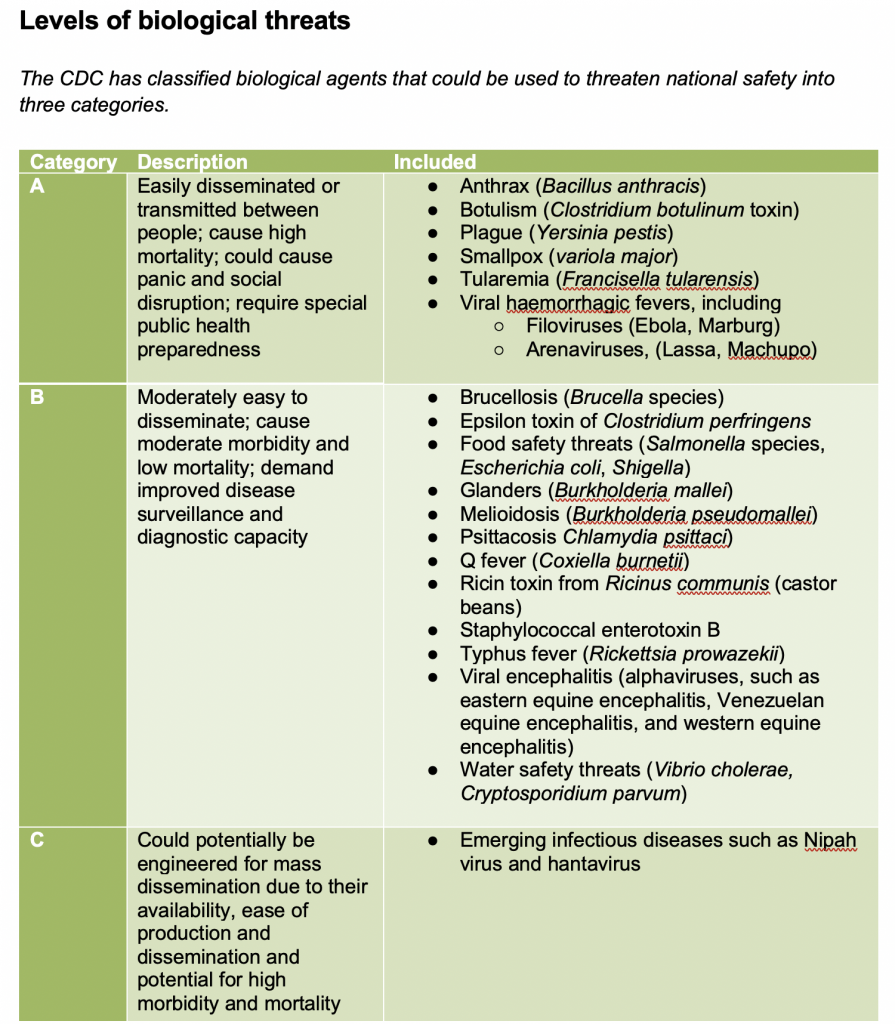The havoc wrought by SARS-CoV-2 highlights our lack of preparedness – thankfully, weaponising a pathogen is harder than you'd think.
It’s September 1984 and a few free-love, religious devotees are visiting their local restaurants with a surprise. What they have is a concoction they call “salsa”, which they are sprinkling across the salad bars.
In the salsa is the bacteria, Salmonella.
More than 700 people fall ill and 45 are hospitalised as a result of this intentional food poisoning.
The plan was to incapacitate enough local residents so the cult could win itself a local election. It was the first and largest act of bioterrorism in the US, although public health investigators initially blamed the outbreak on the poor hygiene of the food handlers.
The attack by members of the Rajneeshee cult has since become an illustration of just how easy it could be for a malicious actor to weaponise everyday microbes and use them to harm the community for a political or ideological purpose.
Now, more than three decades later, we’re seeing the power of another microbe to upend our way of life. The coronavirus responsible for this pandemic has struck economies around the world, infected 20 million and brought travel to a halt. The world hasn’t seen anything like it for a century, and the impacts are unprecedented for almost all living through it.
It’s no wonder that some look at COVID-19 and ask: could you ask for a better result if you wanted to sow massive disruption and chaos?
The threat of biowarfare is often the forgotten sibling of nuclear, chemical and radiological attacks. But with the rapid development of gene-editing technology and shrinking costs, some experts are worried that the world is ripe for another terrorist attack. Or we may even be under attack without realising it.
Fortunately, the evidence suggests that this latest coronavirus occurred naturally. But it is worth asking, how at risk are we of a bioterrorist attack?
New threats
The turn of the century ushered in an era where scientists suddenly had the tools to create synthetic viruses. For professor of global biosecurity Raina MacIntyre, gene-editing a bioweapon is not a far-fetched scenario.
“It is a reality already. Current technology allows us to edit anything with DNA – a Chinese scientist made headlines for editing human embryos and carrying these to term,” she tells The Medical Republic.
And even back in 2001, Australian researchers added an extra gene to a cousin to smallpox, mousepox, to make it lethal even to mice who had been vaccinated. Similarly, in 2011 researchers announced that they had modified bird flu to make it more transmissible in humans.
Huge debate erupted over whether scientific journals should publish the details of this work, which some argued was effectively handing the recipe for a potentially deadly pandemic to malicious actors.
Amplifying this threat was the level of ease with which small-time actors might be able to do this, says Professor MacIntyre, an infectious diseases expert and head of the biosecurity program at the University of NSW’s Kirby Institute.
“Canadian scientists created a pox virus, closely related to smallpox, in a lab from scratch using mail-order DNA and $100,000,” she says.
It is alarming to think that this highly contagious virus, responsible for an estimated half a billion deaths before it was eradicated, could be made so cheaply and easily.
Right now, private companies dedicated to synthetic biology are largely self-regulated. In 2017, there were more than 100 of these companies, and it’s likely there are more now.
Professor MacIntyre warns that Australia is currently taking a more relaxed stand on this development than other countries.
“We do not offer formal guidelines to researchers over and above standard biosafety and ethics requirements (in contrast to the US), have no committee equivalent to the US National Science Advisory Board for Biosecurity or Blue Ribbon Biodefense Panel, and we are quite relaxed about opening the gates,” she says, pointing to Australia removing regulations around the use of CRISPR for research purposes.
Another possible unconventional and natural-seeming line of bioterrorism attack is engineered antimicrobial resistance. The number of multi-resistant bacteria has increased over the last century since the discovery of antibiotics, and their existence could seriously hinder the management of naturally occurring diseases and complicate the management of genetically engineered pathogens.
“The question is, what nefarious activities are under the radar, and do we even ask the question of serious epidemic or antimicrobial resistant threats: ‘is this man-made?’” Professor MacIntyre says.
Just like the Rajneeshee poisoning, there have been a number of outbreaks from human-made pathogens that haven’t been recognised as such at the time.
Beyond antimicrobial resistance, the possibilities “are only limited by the imagination”, Professor MacIntyre says. “The technology is available, accessible and affordable for engineering of pathogens or creating new ones.”
These fears are certainly shared by some security experts. CRISPR Cas9 was rated a leading weapon of mass destruction threat in 2016 by the US Director of National Intelligence.
One reason for that is that while the US and Russia both have a known history of developing biological weapons, ramping up during World War II, more recent evidence has emerged suggesting rogue states and actors such as North Korea and al-Qaeda may also be investing in biological warfare.
Part of the appeal is that biological weapons are cheaper and more easily hidden than nuclear ones.
However, bioweapons aren’t limited to CRISPR-edited pathogens.
OG bioweapons
For Associate Professor David Heslop, a senior medical adviser for the Australian Defence Force and a GP, the biggest worry is conventional and common pathogens rather than horribly dangerous bioengineered ones.
This is primarily because it’s far more achievable with our current technology, and it’s “really difficult” to detect, Professor Heslop tells The Medical Republic.
An attack like the one carried out by the Rajneeshees with Salmonella is “far more likely and achievable” than something involving very dangerous pathogens, says Professor Heslop, also a bioterrorism expert at UNSW. “The more dangerous the pathogen is to handle, the more likely that you’re going to hurt yourself by developing and handling it.”
In contrast, people are poisoned by food all the time due to poor handling practices, so the bacteria would be relatively easy to obtain and culture in a DIY laboratory.
The US Centers for Disease Control and Prevention (CDC) categorises pathogens into three categories based on their threat to national security.
Those in Category A have great potential for damage because they can be easily transmitted from person to person or disseminated. These agents would also cause public panic and social disruption, they would cause public health organisations to devote their resources to managing the issue,rather than their usual work. Finally, the agents have a tremendous potential for high morbidity and mortality. Category A agents include pathogens such as anthrax and smallpox.
Professor Jeff Ryan, a lecturer in preparedness, disaster relief, bioterrorism response and homeland security at Jacksonville State University in the US, says that in security circles, our old friend anthrax is the major threat: “It’s the king.”
While it isn’t communicable from person to person, formulate it correctly and the spores could be easily spread through the air. “So if you have an organisation that has either acquired or produced a sophisticated preparation of Bacillus anthracis spores, and has the resources and the technology to formulate it and release it in an effective manner, it could be devastating,” Professor Ryan says.
The “Amerithrax” attack that occurred shortly after 9/11, where letters with anthrax spores were mailed to politicians and media outlets, illustrated how much fear and chaos that could cause.
Five died and 17 were infected in that attack, which has been contentiously blamed on an anthrax vaccine developer. Billions of dollars have been spent to counter the threat in the years since, including ongoing anthrax surveillance in the US postal service.
However, Professor Ryan doubts that an individual or group is seriously working on that right now. This is because of how difficult it is to produce a large-scale viable bacterial or viral concoction that would be expertly disseminated, maintain its viability through the dissemination process, and manage to infect hundreds, if not thousands of people.
“I think a lot of that is science fiction, rather than science fact. It takes a considerable amount of technology and resources and skills to be able to pull off something like that,” he says.
Even the Rajneeshees, with all of their resources and a medical lab, weren’t able to pull off a particularly damaging attack.
While it is possible for small-scale actors to launch a terrorist attack with something such as ricin or E. coli, Professor Ryan believes they would be better served using explosives or industrial chemicals that are readily available and don’t require such careful production.
“I tend to think of the threat as a low-probability, high-consequence event,” he said. “It’s not likely to happen, but if it did, wow, it could be devastating.”
Who’s the scariest?
For Professor Ryan, the technology needed to successfully pull off a major attack would require state actors. But this, he thinks, makes it unlikely in its own way.
“A state-sponsored attack may be highly risky because of how the developed world would counter such an attack,” he says. “If somebody was to use biological weapons against the United States, and it was tracked to a state sponsored program or it was a direct act of war, we might retaliate with nukes.”
That’s because while the US and other countries have given up their biological and chemical weapon stockpiles, they have made it clear that nuclear weapons may still be kept as a deterrent.
There are also so many technological hurdles that a large, state-sponsored program and a small, rogue one alike would have to overcome. The reality of developing a sophisticated bioweapons program means that the creators will want to test their pathogens in nature to see how they survive and how they spread in the sun or wind, for example.
“The reason why the plague, Yersinia pestis, was never really a good biological weapon is because it readily degrades in UV light,” Professor Ryan says. “Once the sun comes out, it starts to immediately degrade what you’ve deposited.”
And while there have been spills from research centres that were detected, there is little evidence of new and interesting pathogens being found by surveillance systems, says Dr Martin Boland, a specialist in chemical, biological, radiological and nuclear weapons.
Alarm bells would ring if we found something that looked like Ebola turning up in Afghanistan, or something like SARS in Nigeria, Dr Boland says.
Moreover, biological weapons are simply less reliable and more prone to blow back against your own citizens or soldiers compared with traditional explosives, even chemical and nuclear weapons.
Any plan for Chinese military leaders to unleash SARS-CoV-2 on the world, as conspiracy theorists have suggested occurred, would have been simply too prone to failure, he says. There was no way for those military commanders to be certain that the US would so severely mismanage their response to the pandemic – in other circumstances, swifter action and more scientifically informed responses could have averted much of the destruction.
“On a strategic or tactical level, using a biological weapon is so fraught with problems that no moderately sane military or political commander would use it,” Dr Boland adds.
Are we prepared?
Ultimately, it would be very hard to determine whether an outbreak of a food-borne illness such as Salmonella was a bioweapon, and this in itself might be a disincentive for an individual or group whose aim was to strike fear into the population.
Researchers worked on bioweapons for decades before the superpowers decided to dismantle their labs. Some of what we know from that time is alarming, other information drives home how hard it is to turn a pathogen into a practical weapon that won’t harm your own soldiers, that will spread well and that will survive in the elements.
For Professor Ryan, the huge amounts of money dedicated to defending against a biological attack would be better spent on curing or improving the management of diseases we are already affected by, such as HIV, tuberculosis, resurgent measles and food- or waterborne illnesses.
The pandemic has highlighted how important it is for Australia to protect its baseline level of capacity, so we can adapt to a new situation quickly before it gets out of control, Professor Heslop says.
So improving how we handle a pandemic like the one we’re seeing today would double as a bioterrorism defence strategy. This means building our capacity to ramp up new diagnostic tools and developing broad spectrum treatments and vaccines.
“One of the biggest advantages that we have is a state-based, free healthcare system,” Professor Heslop says. This means that when people need testing and treatment, they can get it regardless of which stratum of society they come from.
While there is little evidence that recent infectious disease outbreaks have been intentional, Professor Heslop says they are unusual.
“There are so many new pathogens emerging that there is concern about bioterrorism,” he says. “But what I’m more concerned about is actually nature throwing more and more novel agents at us all the time due to a range of factors, like climate change and habitat encroachment.”
With rising global temperatures and deforestation expected to drive up the risks of zoonotic diseases, a modern-day cult of Rajneeshees may be the least of our worries.





